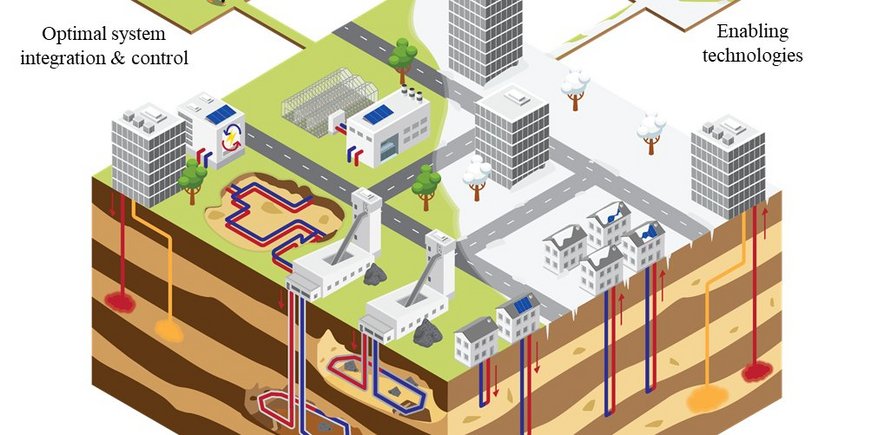Piloting Underground Storage of Heat In geoThermal reservoirs - PUSH-IT
![[Translate to English:] PUSH-IT Logo](/fileadmin/_processed_/6/1/csm_Logo_push-it_final_verticaal_6515e346b5.png)
The EU aims to have a net-zero greenhouse gas (GHG) economy by 2050, with 55% reduction on 1990 levels by 2030. At present, heating and cooling represent around 50% of the final energy demand in Europe and are mainly supplied by fossil fuel derived energy. It is therefore essential for heating and cooling to decarbonise to achieve EU ambitions.
A challenge for decarbonizing heat systems is the size of the seasonal mismatch between demand for heat and heat generation from sustainable sources – this mismatch is much larger than the equivalent intermittency in electricity supply and demand. The two main solutions to address this mismatch are: (i) to install a large capacity, so that peak demands can be met even at low production levels; or (ii) to store energy for later use if it is not needed at time of conversion. Many sustainable heat supply systems are characterised by high capital expenditure and low operational costs. Therefore, an installed capacity tailored at peak demand is not cost effective, while extending the annual operation period is advantageous for meeting energy needs, reducing levelised cost of energy (LCOE) and decarbonisation. Optimal utilisation of sustainable heat requires storing large amounts of heat to account for seasonal supply and demand fluctuations. Various technologies have been proposed for large-scale heat storage in geothermal reservoirs and low temperature storage is routinely applied. PUSH-IT focuses on extending storage temperature ranges to high temperatures. We will tackle remaining barriers, demonstrate applicability, increase public engagement, and optimise and de-risk operations. We will showcase three technology options that are fit for a wide variety of geological conditions covering most locations in Europe.
The main objective of PUSH-IT is to showcase the full-scale applications of heat storage (up-to 90°C) of 3 different technologies in geothermal reservoirs at 6 different sites with various societal, heat network and geologic conditions relevant across Europe. PUSH-IT will implement, develop and test the ability of Mine, Borehole and Aquifer Thermal Energy Storage technologies (MTES, BTES and ATES) to store and recover heat:
- Prove 3 different concepts (ATES, BTES and MTES) in operational demonstration projects.
- Enable joint decision making of citizens, regulators and operators to increase social acceptance.
- Development of enabling technologies to adapt thermal energy storage in mines (MTES), in boreholes (BTES) and in aquifers (ATES) to a wide range of geological conditions
- Develop an open-source tool to assess and optimise LCOE reduction and costs of carbon emission reduction.
- Optimised integration in heat systems via co-simulation and machine learning.
GFZ’s main tasks in the project are:
- GFZ is site-lead for the follower-site Berlin Adlershof, where the installation of an ATES system for the supply to the district heating network of BTB GmbH is planned.
- Development, application and evaluation of Hot-Push-Pull Tests in Berlin, Delft and maybe Bochum. The performance of pilot demonstration sites will be monitored to understand the impacts of heat storage, focusing on thermal/hydraulic/mechanical/chemical changes in the environment.
- Development of new performance monitoring, water quality and impact monitoring and water treatment methods to increase system longevity.
- Optimisation of the integration in heat systems via co-simulation
Funded by the European Commission, Research and Innovation programme Horizon Europe, Project-ID 101096566
- Technical University Delft
- Equans Nederland BV
- KWR Water BV
- Technical University Darmstadt
- Fraunhofer-Einrichtung für Energieinfrastrukturen und Geothermie IEG
- Vlaamse Instelling voor Technologisch Onderzoek -VITO
- Česká geologická služba
- Huisman Geo BV
- Bureau de Recherches Geologiques et Minières (BRGM)
- University Utrecht
- Grondboorbedrijf Haitjema B.V.
- Univerzita Karlova
- Université de Genève
- Anglia Ruskin University
- Geothermal Engineering Ltd.
- British Geological Survey
- University of Exeter



